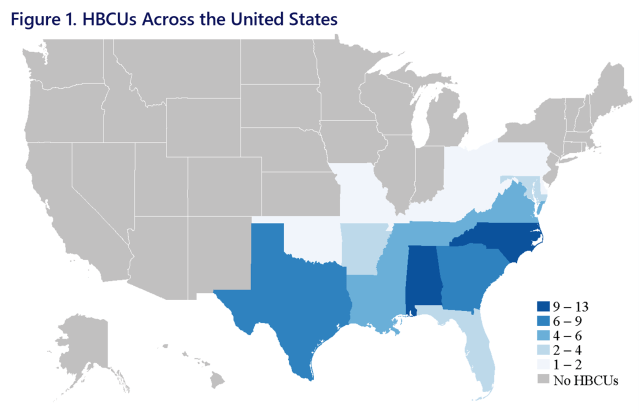The White House
1600 Pennsylvania Ave NW
Washington, DC 20500
Historically Black Colleges and Universities (HBCUs) have been essential institutions for educating Black Americans since the early 19th century. Before the legal integration of education in the 1950s and 1960s, Black students were prevented from obtaining higher education at many state and private colleges. This led to the establishment of colleges and universities with the explicit mission of educating Black students. Although the legal landscape, social fabric, and education system of the United States has changed significantly since the mid-1900s, many of the schools founded during that era to educate Black students still exist today and carry forward their rich legacy of higher education for more than 180 years as HBCUs: Congressionally defined as institutions established before 1964 with the primary mission of educating Black Americans.
This issue brief highlights a few key facts about the importance of HBCUs in the higher education and economic mobility of Black Americans and highlights historic administration actions to support them:
Although the first recorded Black student enrolled in an American post-secondary institution enrolled at the turn of the nineteenth century, and the first bachelor’s degrees awarded to Black men and women were awarded in 1823 and 1862, respectively, educational opportunities for Black students were long suppressed. In 1837, the first HBCU was established with the express goal of educating Black Americans for gainful employment. The majority of these institutions were established in the decades immediately following the Emancipation Proclamation in 1865. Until post-secondary education was legally desegregated by Brown v. Board of Education, nearly all Black students were educated at what are now known as HBCUs.
Today, despite comprising a small fraction of U.S. higher education institutions, HBCUs have continued to make major contributions to the academic achievements of Black Americans. As of 2022, 99 accredited HBCUs operate across 19 states, the District of Columbia, and the U.S. Virgin Islands (Figure 1). While they accounted for just 8 percent of Black undergraduate enrollment in 2021, HBCUs conferred 13 percent of all bachelor’s degrees earned by Black students and nearly one quarter of all bachelor’s degrees earned by Black students in science, technology, engineering, and mathematics (STEM) (NCES, 2024; George-Joseph and Kodnani, 2023).
Recent evidence shows that HBCUs’ outsized impact reflects their very large “value added”—that is, HBCUs improve student outcomes by a larger margin than many other schools.
Important early research compared those who enrolled at HBCUs and Traditionally White Institutions (TWIs) and found that HBCU matriculation was associated with higher wages and an increased probability of graduation in the 1970s, but that this was no longer the case by the 1990s. This “fading-out” of the benefits of HBCUs over time called into question the relative benefits of HBCUs in present day. Much of the older literature, however, looks only at individuals who ultimately enroll in college. In other words, previous work assumed that if a student did not attend a four-year HBCU, they would still go on to attend a four-year college or university. More recent research shows that this assumption often does not hold: there are significant numbers of Black men and women who likely would not make it to college at all absent HBCUs, casting serious doubt on the initial conclusion that HBCU may no longer confer benefits on Black students.
Specifically, Edwards et al. (2023) use a sample of over one million Black SAT takers between 2004 and 2010, and find that, because of differences in application patterns, students who apply to HBCUs are less likely than their peers to go to a four-year college without the opportunity to enroll in an HBCU. Specifically, the fallback option for students who send their SAT score to at least one HBCU is more likely to be a two-year school or no college. This shows that (a) the typical Black student who enrolls at an HBCU may be very different than one who enrolls at a non-HBCU, and (b) ignoring the role of HBCUs in promoting 4-year college enrollment may drastically understate the benefits of enrolling in an HBCU for subsequent outcomes. Using a more appropriate basis for comparison (i.e., all students who enrolled at an HBCU versus those that did not), the authors found that enrolling in an HBCU was associated with a 14.6 percentage point increase in the probability of earning a BA and 5 percent higher household income by around age 30.
Due to HBCUs’ large, positive effects on enrollees, and because they are more likely than other schools, on average, to enroll students from disadvantaged backgrounds, HBCUs are powerful engines of upward social mobility. Research from Chetty et al. (2020) uses data from anonymized tax records to explore how colleges help or hinder social mobility. Among the HBCUs included in the sample (roughly half of all four-year HBCUs), about 24 percent of students at the average HBCU are from families in the bottom 20 percent of the income distribution – more than twice the rate of the average four-year school.
In addition, Figure 3 shows that about 30 percent of all students in four-year HBCUs ascend two or more income quintiles between childhood and age 30. This contrasts with four-year non-HBCUs, where only 18 percent of students do the same; the share is slightly higher at public four-year institutions. If we compare HBCUs to elite, predominantly white institutions like Yale, Princeton, and Harvard, roughly 10 percent of students achieve the same mobility. This discrepancy stems from two factors: (1) elite institutions enroll fewer students who can move up two income quintiles (because they are more likely to enter in one of the top two income quintiles), and (2) HBCUs both admit a large number of students from the bottom of the income distribution and successfully move them up the income distribution, thus generating social mobility.
Survey research highlights that HBCUs’ unique ability to foster upward mobility may be due to higher rates of mentorship, support, and experiential learning opportunities compared to non-HBCU institutions (Price and Viceisza, 2023). Qualitative research in sociology and psychology also finds that HBCUs are effective in cultivating a sense of belonging and a “culture of success” among students, aligning with their degree granting and graduation patterns. Beyond their excellence in educating Black students, HBCUs offer a unique space for students who have been historically excluded from predominantly white institutions. This was the founding mission of HBCUs: to educate Black students when other institutions wouldn’t. Today, despite having the choice to attend any institution, more Black students are choosing HBCUs (see Figure 4). The increase in HBCU enrollment over the last two years contrasts with the overall decline at other postsecondary institutions nationwide. Moreover, there has been a historic spike in applications to HBCUs since 2020: some HBCUs reported up to a 30 percent increase in applications between the 2019 and 2021 cycles.
Standard economic theory (and common sense) dictates that when particular sectors are highly productive, one should invest more heavily in these sectors. However, this has not been the case with HBCUs—which historically have been relatively underfunded. We discuss the details of this below.
First, public HBCUs have been historically underfunded compared to their non-HBCU peers, especially those institutions that are land-grant universities. Under the Second Morrill Act of 1980, states opening a second land-grant university to serve Black students were required to provide an equitable distribution of state funds to each institution. Using data from the National Center for Education Statistics (NCES), the Departments of Education and Agriculture found state-level discrepancies in per student funding that aggregate to severe financial gaps: $172 million to $2.1 billion per state between 1987 and 2020. Research finds that funding, especially at public institutions, can have significant impacts on downstream student outcomes: increases in state appropriations can reduce student debt burdens and—at the two-year level—can improve degree attainment (Chakrabarti et al, 2020) and increased spending has important, positive impacts on postsecondary enrollment, persistence, and completion (Deming and Walters, 2017).
Across both public and private institutions, HBCUs have much smaller endowments than non-HBCUs, owing in-part to historic inequities and discriminatory practices—such as redlining and blockbusting—that have led to large racial wealth gaps that can contribute to racial gaps in giving. Indeed, research shows that per full-time student, the endowment for public HBCUs was about 50 percent of the endowment for public non-HBCUs in 2021. The gap is larger at private institutions, where the average HBCU endowment per full time student is about 21 percent of non-HBCUs. Despite several high-profile private donations to HBCUs since 2020, the endowment gap has grown over time, especially recently at private institutions (Figure 5).
Discrepancies in both private and public funding leave HBCUs to be highly reliant on tuition and fees for funding. This creates a fundamental mismatch with the needs of Black students, who are more likely to come from lower-income families and need additional financial supports. These funding structures are particularly problematic in times of economic downturn; whereas other institutions are able to leverage a combination of endowments and public funding to minimize tuition increases and offset operating costs, HBCUs are left to rely more heavily on revenue from tuition and fees and may be more likely to raise tuition.
The Biden-Harris Administration has taken historic action in supporting HBCUs, recognizing their high return on investment despite generations of unequal funding. In September 2023, the Secretaries of Agriculture and Education called on 16 states to rectify a $12 billion funding discrepancy between land-grant HBCUs and their non-HBCU counterparts. States have failed to fulfill their legal obligation to provide equitable funding to HBCUs for nearly four decades, and the Biden-Harris Administration has underscored the need to right these historical wrongs. The Administration has also invested over $16 billion in HBCUs through the American Rescue Plan, capital finance debt relief, grant funding to expand academic capacity, and financial aid and other educational benefits for HBCU-enrolled students and veterans.
HBCUs have particularly benefited from the Administration’s higher education funding initiatives. First, although the Pell grant program is race neutral, HBCU students are more likely to meet the eligibility requirements than their non-HBCU peers, meaning that the recent $900 increase in Pell Grants, the largest in a decade, has made college more affordable for the 75 percent of HBCU students who rely on these grants. The Administration’s Saving on a Valuable Education Plan (SAVE) eases student loan repayment, which is especially important for Black students who have historically shouldered a disproportionate loan burden. An Urban Institute analysis estimates that 59 percent of credentials earned by Black students could be eligible for loan forgiveness under SAVE, compared to 42 percent for white students (Delisle and Cohn, 2023). The SAVE plan’s outsized impact on low-income borrowers makes it particularly salient for HBCUs, who enroll a disproportionate number of students from the bottom of the income distribution —allowing HBCU graduates to benefit from the upward mobility fostered by their institution without being overburdened by student debt.
The Biden-Harris Administration has a strong record of supporting HBCUs, and has set an example across the Federal government to do the same. Other initiatives across the U.S. Air Force, the Departments of Education, Commerce, Transportation, Energy, as well as NASA and the National Science Foundation have pioneered new programs to support HBCUs since 2021. By setting an example of recognizing the achievements of HBCUs, the Administration is drawing in investment and support from all angles to lift up the unique success of HBCUs across the country.
We’ll be in touch with the latest information on how President Biden and his administration are working for the American people, as well as ways you can get involved and help our country build back better.
Opt in to send and receive text messages from President Biden.
The White House
1600 Pennsylvania Ave NW
Washington, DC 20500
The Economics of HBCUs | CEA – The White House











More Stories
Black Kos Tuesday: Thanking you for your service! – Daily Kos
Trump’s elimination of federal employees could shrink the Black middle class – TheGrio
Pentagon restores pages on Black MOH recipient, Japanese American unit – Military Times